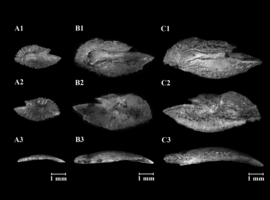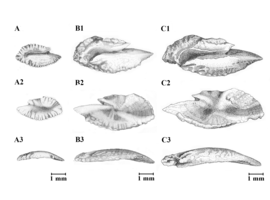Chloroscombrus chrysurus (Linnaeus, 1766)
(Carangidae, Perciformes)
Distribui-se de Massachusetts à Argentina. Em geral não ultrapassa 30 cm de comprimento. Habita aguas litorâneas, de preferencia baias e estuários, formando grandes cardumes. Alimenta-se de organismos planctônicos, principalmente de crustáceos (Menezes & Figueiredo, 1980; Menezes et al. 2003).
The collection contains otoliths from 724 individuals of this species, ranging from 38 to 372 mm of total length. Click here to see the map of the sampling area for the individuals of this species. The following summaries contains data from 95 analysed otoliths. See more detailed data here (in portuguese).


Otoliths from Chloroscombrus chrysurus, with total length of A. 115mm; B. 242mm; C. 354mm; internal side A1; B1; C1; external side A2; B2; C2; profile of the ventral region A3; B3; C3; click the figures for larger version*
Morphology:
Shape: elliptic to lanceolated (98%), elliptic (2%). Anterior region: lanceolated (57%), lanceolated-round (41%), peaked-round (2%). Posterior region: angled-round (79%), rounded (16%), angled (5%). Dorsal edge: sinuate (43%), lobed to sinuate (38%), sinuate to entire (13%), crenate to sinuate (3%). Ventral edge: sinuate (46%), lobed to sinuate (26%), serrate to sinuate (15%), sinuate to entire (7%). Profile: concave-convex. Rostrum and antirostrum orientation: in disagreement (72%), in agreement (28%). Rostrum: Developed. Antirostrum: underdeveloped (68%), Developed (29%), absent (2%). Pseudorostrum: absent. Pseudoantirostrum: absent. Sulcus acusticus: position supramedian, orientation horizontal, opening ostial, morphology heterosulcoid, colliculum absent, ostium funnel-like, cauda strongly curved tubular (71%), markedly curved tubular (29%).
Description of the terms used
Morphometry:
| Shape indices | Mean ± sd | Minimum | Maximum |
|---|---|---|---|
| OL / TL % | 2.41 ± 0.29 | 1.61 | 2.98 |
| OH / OL % | 47.64 ± 4.27 | 39.08 | 57.60 |
| OT / OL % | 17.13 ± 1.81 | 12.77 | 21.32 |
| OT / OH % | 36.18 ± 4.63 | 25.29 | 47.31 |
| Circularity | 22.62 ± 1.62 | 19.33 | 28.57 |
| Rectangularity | 0.63 ± 0.02 | 0.59 | 0.68 |
* Vouchers:
Collection identifier for the individuals shown on photography and drawings:
- 25.13.CHCH.SARIV.AM.9.7 (115 mm)
- 25.13.CHCH.SARV.AM.13.7 (242 mm)
- 25.13.CHCH.SARVI.AM.13.1 (354 mm)
For more information about this species:





